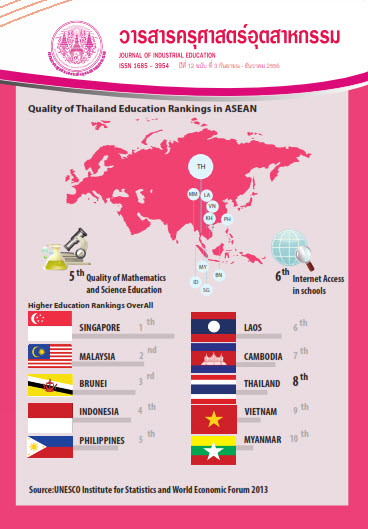Effects of Program Embedded Calculating for Science in Web-Based Instruction on Works and Energy
Keywords:
Program Embedded Calculating for Science, Web-Based Instruction, efficiency, Learning AchievementAbstract
The proposes of this research were to construct and find out the efficiency of the Embedded Calculating Program for Science in Web-Based Instruction on Works and Energy, then compared the learning achievement between the experimental group that learned with the Embedded Calculating Program for Science in Web-Based Instruction and the controlled group that learned with the Web-Based Instruction without Embedded Calculating Program. In this study, the 1st year high school students of 40 students from Srinamkumsuksa School were used to be the sample by using the Sample Random Sampling method. The sample was divided into two groups, which each group equals to 20 students. The experimental group learned with the Embedded Calculating Program for Science in Web-Based Instruction while the controlled group that learned with the Web-Based Instruction without Embedded Calculating Program. The Web-Based Instruction with Embedded Calculating Program for Science efficiency was obtained from the experimental group’s learning achievement. Then, the achievement scores of experimental group were compared with the controlled group. The data was analyzed by using the Independent Sample t-test. The results of this study was concluded that the effectiveness of the Web-Based Instruction with Embedded Calculating Program for Science had the effectiveness at 84.25:81.25 which met the standard criteria at 80:80, and the learning achievement of the subjects who learned with Web-Based Instruction with Embedded Calculating Program for Science was significantly higher than those who learned with the Web-Based Instruction without Embedded Calculating Program at .05 levels.
References
[2] ชัยยงค์ พรหมวงศ์ และคณะ. 2520. ระบบสื่อการสอน. กรุงเทพฯ: โรงพิมพ์จุฬาลงกรณ์มหาวิทยาลัย.
[3] ศิริรัตน์ เพ็ชร์แสงศรี. 2546. หลักการออกแบบบทเรียนบนเครือข่ายอินเทอร์เน็ต. กรุงเทพฯ: คณะครุศาสตร์อุตสาหกรรม สถาบันเทคโนโลยีพระจอมเกล้าเจ้าคุณทหารลาดกระบัง. (เอกสารประกอบการเรียน)
[4] ล้วน สายยศ และอังคณา สายยศ. 2540. สถิติวิทยาทางการวิจัย. กรุงเทพฯ: สุวีริยสาสน์.
[5] ธณัฐภรณ์ สนิทมาก. 2555. การพัฒนาบทเรียนผ่านเครือข่ายอินเทอร์เน็ต เรื่องนิพจน์และตัวดำเนินการ สำหรับนักเรียนชั้นมัธยมศึกษาปีที่ 5 โรงเรียนแก่งคอย จังหวัดสระบุรี. วารสารครุศาสตร์อุตสาหกรรม, 11(2), 146-152.
[6] อัญชลี เตมา. 2551. บทเรียนบนเครือข่ายอินเทอร์เน็ต เรื่องสารเคมีในชีวิตประจำวัน. วิทยานิพนธ์ครุศาสตร์อุตสาหกรรมมหาบัณฑิต สาขาวิชาเทคโนโลยีการศึกษาทางการอาชีวะและเทคนิคศึกษาบัณฑิตวิทยาลัย สถาบันเทคโนโลยีพระจอมเกล้าเจ้าคุณทหารลาดกระบัง.
[7] ปรียา นาคเงินทอง. 2553. บทเรียนบนเครือข่ายอินเทอร์เน็ต เรื่องการอ่านและเขียนสูตรสารประกอบไฮโดรคาร์บอนและอนุพันธ์ของไฮโดรคาร์บอน. วิทยานิพนธ์ครุศาสตร์อุตสาหกรรมมหาบัณฑิต สาขา วิชาเทคโนโลยีการศึกษาทางการอาชีวะและเทคนิคศึกษาบัณฑิตวิทยาลัย สถาบันเทคโนโลยีพระจอมเกล้าเจ้าคุณทหารลาดกระบัง.
[8] เมตตา เขียวคำรพ. 2551. บทเรียนบนเครือข่ายอินเทอร์เน็ต เรื่องขนมไทย. วิทยานิพนธ์ครุศาสตร์อุตสาหกรรมมหาบัณฑิต สาขาวิชาเทคโนโลยีการศึกษาทางการอาชีวะและเทคนิคศึกษาบัณฑิตวิทยาลัย สถาบันเทคโนโลยีพระจอมเกล้าเจ้าคุณทหารลาดกระบัง.
Downloads
Published
How to Cite
Issue
Section
License
"The opinions and contents including the words in papers are responsibility by the authors."
"ข้อคิดเห็น เนื้อหา รวมทั้งการใช้ภาษาในบทความถือเป็นความรับผิดชอบของผู้เขียน"



